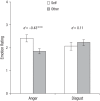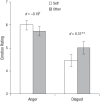Disgust and Anger Relate to Different Aggressive Responses to Moral Violations
- PMID: 28485700
- PMCID: PMC5426557
- DOI: 10.1177/0956797617692000
Disgust and Anger Relate to Different Aggressive Responses to Moral Violations
Abstract
In response to the same moral violation, some people report experiencing anger, and others report feeling disgust. Do differences in emotional responses to moral violations reflect idiosyncratic differences in the communication of outrage, or do they reflect differences in motivational states? Whereas equivalence accounts suggest that anger and disgust are interchangeable expressions of condemnation, sociofunctional accounts suggest that they have distinct antecedents and consequences. We tested these accounts by investigating whether anger and disgust vary depending on the costs imposed by moral violations and whether they differentially correspond with aggressive tendencies. Results across four studies favor a sociofunctional account: When the target of a moral violation shifts from the self to another person, anger decreases, but disgust increases. Whereas anger is associated with high-cost, direct aggression, disgust is associated with less costly indirect aggression. Finally, whether the target of a moral violation is the self or another person influences direct aggression partially via anger and influences indirect aggression partially via disgust.
Keywords: aggression; anger; disgust; emotions; morality; open data; open materials.
Conflict of interest statement
Figures





Similar articles
-
Many moral buttons or just one? Evidence from emotional facial expressions.Cogn Emot. 2019 Aug;33(5):943-958. doi: 10.1080/02699931.2018.1520078. Epub 2018 Sep 11. Cogn Emot. 2019. PMID: 30200861
-
Morality is relative: Anger, disgust, and aggression as contingent responses to sibling versus acquaintance harm.Emotion. 2021 Mar;21(2):376-390. doi: 10.1037/emo0000707. Epub 2019 Dec 12. Emotion. 2021. PMID: 31829720
-
The interactive effect of anger and disgust on moral outrage and judgments.Psychol Sci. 2013 Oct;24(10):2069-78. doi: 10.1177/0956797613486988. Epub 2013 Aug 22. Psychol Sci. 2013. PMID: 23969778
-
Bodily moral disgust: what it is, how it is different from anger, and why it is an unreasoned emotion.Psychol Bull. 2013 Mar;139(2):328-51. doi: 10.1037/a0029319. Psychol Bull. 2013. PMID: 23458436 Review.
-
Things rank and gross in nature: a review and synthesis of moral disgust.Psychol Bull. 2013 Mar;139(2):300-27. doi: 10.1037/a0030964. Psychol Bull. 2013. PMID: 23458435 Review.
Cited by
-
Individual Differences in Political Ideology and Disgust Sensitivity Affect Real-Time Spoken Language Comprehension.Front Psychol. 2021 Oct 11;12:699071. doi: 10.3389/fpsyg.2021.699071. eCollection 2021. Front Psychol. 2021. PMID: 34707531 Free PMC article.
-
The Appraisal Model of Conspiracy Theories (AMCT): Applying Appraisal Theories to Understand Emotional and Behavioral Reactions to Conspiracy Theories.Psychol Inq. 2025 Mar 13;35(3-4):159-178. doi: 10.1080/1047840X.2024.2442906. eCollection 2024. Psychol Inq. 2025. PMID: 40104213 Free PMC article.
-
Emotions Induced by Recalling Memories About Interpersonal Stress.Front Psychol. 2021 Apr 9;12:618676. doi: 10.3389/fpsyg.2021.618676. eCollection 2021. Front Psychol. 2021. PMID: 33897528 Free PMC article.
-
Reductions in perceived COVID-19 threat amid UK's mass public vaccination programme coincide with reductions in outgroup avoidance (but not prejudice).Br J Soc Psychol. 2022 Oct;61(4):1286-1304. doi: 10.1111/bjso.12537. Epub 2022 Mar 31. Br J Soc Psychol. 2022. PMID: 35357017 Free PMC article.
-
Nostalgia increases punitiveness by intensifying moral concern.Sci Rep. 2024 May 19;14(1):11425. doi: 10.1038/s41598-024-61858-x. Sci Rep. 2024. PMID: 38763931 Free PMC article.
References
-
- Archer J. (2004). Sex differences in aggression in real-world settings: A meta-analytic review. Review of General Psychology, 8, 291–322. doi:10.1037/1089-2680.8.4.291 - DOI
-
- Björkqvist K., Lagerspetz K. M. J., Österman K. (1992). Direct & Indirect Aggression Scales (DIAS). Retrieved from https://www.vasa.abo.fi/svf/up/dias.htm
-
- Brauer M., Chekroun P. (2005). The relationship between perceived violation of social norms and social control: Situational factors influencing the reaction to deviance. Journal of Applied Social Psychology, 35, 1519–1539. doi:10.1111/j.1559-1816.2005.tb02182.x - DOI
MeSH terms
LinkOut - more resources
Full Text Sources
Other Literature Sources

